Sample: Insert an image in the webpage
This sample uses JavaScript code to insert the stars.jpeg image at the top of the current webpage, inside the <body> element. The extension's pop-up contains a title and an HTML button that's labelled Display. When you click the Display button, the extension's JavaScript code sends a message from the extension icon's pop-up, and dynamically inserts JavaScript that runs in the browser tab.
This sample demonstrates the following extension features:
- Injecting JavaScript libraries into an extension.
- Exposing extension assets to browser tabs.
- Including content webpages in existing browser tabs.
- Having content webpages listen for messages from pop-ups and respond.
Preview of the sample
You'll open the Part 2 extension from the Extensions (![]() ) button after installing the extension via the Manage Extensions tab:
) button after installing the extension via the Manage Extensions tab:
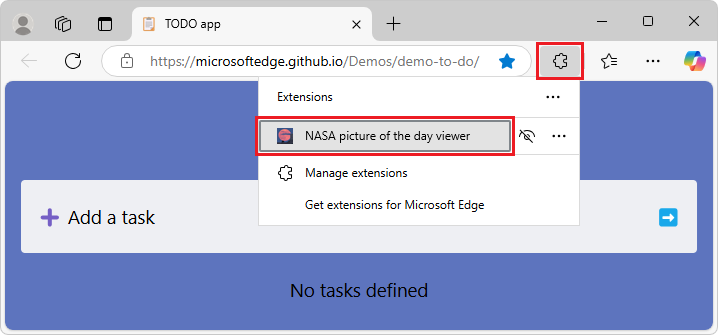
The extension displays a small HTML page in a pop-up, containing a title, instructions, and a Display button:
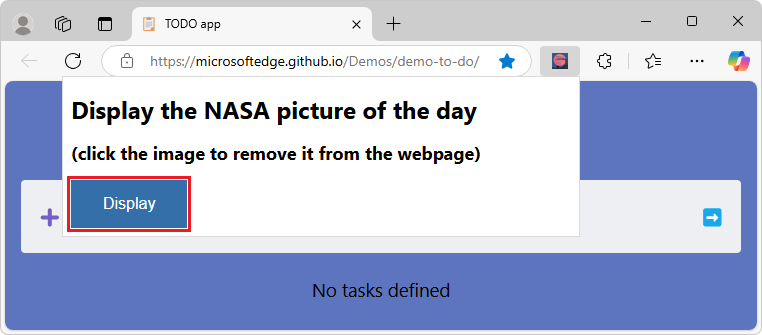
When you click the Display button, JavaScript code temporarily inserts stars.jpeg at the top of the current webpage, pushing down the content of the webpage to below the image. The injected content sets the image element to display the static image stars.jpeg in the top of the current webpage:
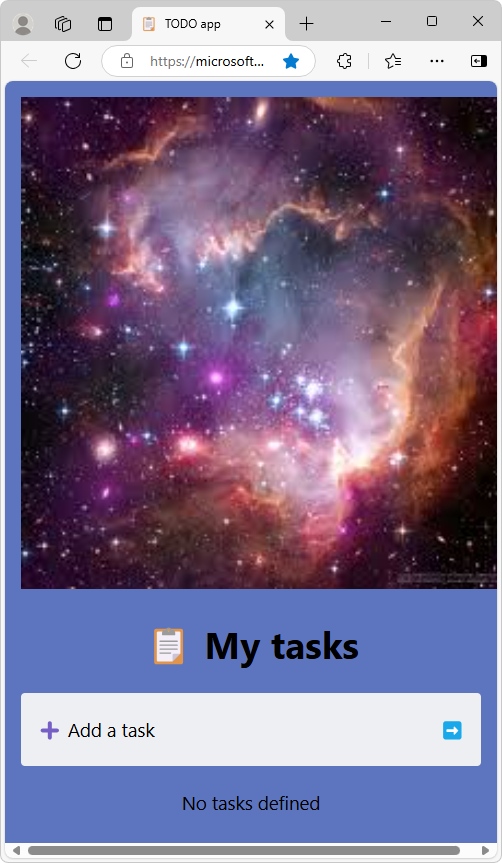
When you click the image, the injected JavaScript removes the image from the DOM tree and webpage.
Obtain, install, and run the sample as follows.
Clone the MicrosoftEdge-Extensions repo
You can use various tools to clone a GitHub repo. You can download a selected directory, or clone the entire repo. These instructions use GitHub Desktop to clone the repo and switch to a working branch.
To clone the MicrosoftEdge-Extensions repo to your local drive:
If not done already, install GitHub desktop: go to https://github.com/apps/desktop, and then click the Download now button.
Go to MicrosoftEdge-Extensions.
Click the Code button, and then select Open with GitHub Desktop.
A dialog opens, saying This site is trying to open GitHubDesktop.exe.
Click the Open button.
GitHub Desktop opens, with the MicrosoftEdge-Extensions repo selected in the upper left dropdown list.
Or, in GitHub Desktop, the Clone a repository dialog opens:
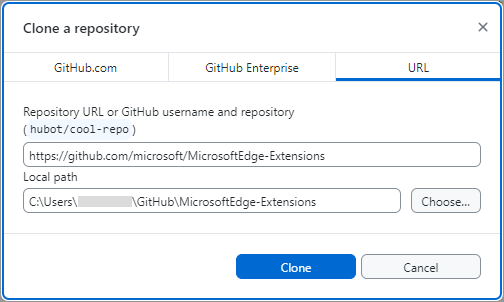
Specify the local drive path to place the cloned repo directory into; for example:
C:\Users\accountname\GitHub\.Click the Clone button.
Create working branch:
In GitHub Desktop, make sure that in the upper left of GitHub desktop, Current repository is MicrosoftEdge-Extensions.
In the Current branch drop-down list, it says main.
In the Current branch drop-down list, click the Branches tab, and then click the New branch button.
The Create a branch dialog opens.
In the Name text box, enter a branch name, such as ext-sample-2, and then click the Create branch button.
In the upper middle and lower left of GitHub Desktop, the current branch is shown, such as ext-sample-2.
You are now free to modify the code in your working branch, without altering the code that's in the "main" branch of the repo. Later you might want to switch back to the "main" branch, or create a different branch based off the "main" branch.
Install the sample locally
Instead of installing the sample from the Store, you'll install the sample locally, so that you can possibly modify it and quickly test the changes. Installing locally is sometimes called sideloading an extension.
In Microsoft Edge, click the Extensions (
 ) button, next to the Address bar, if this icon is displayed. Or, select Settings and more (...) >
) button, next to the Address bar, if this icon is displayed. Or, select Settings and more (...) >  Extensions. The Extensions pop-up opens:
Extensions. The Extensions pop-up opens: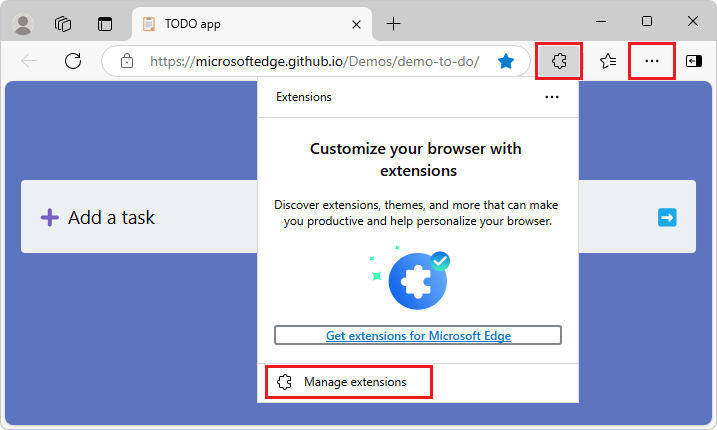
Click Manage extensions. The Extensions management page opens in a new tab:
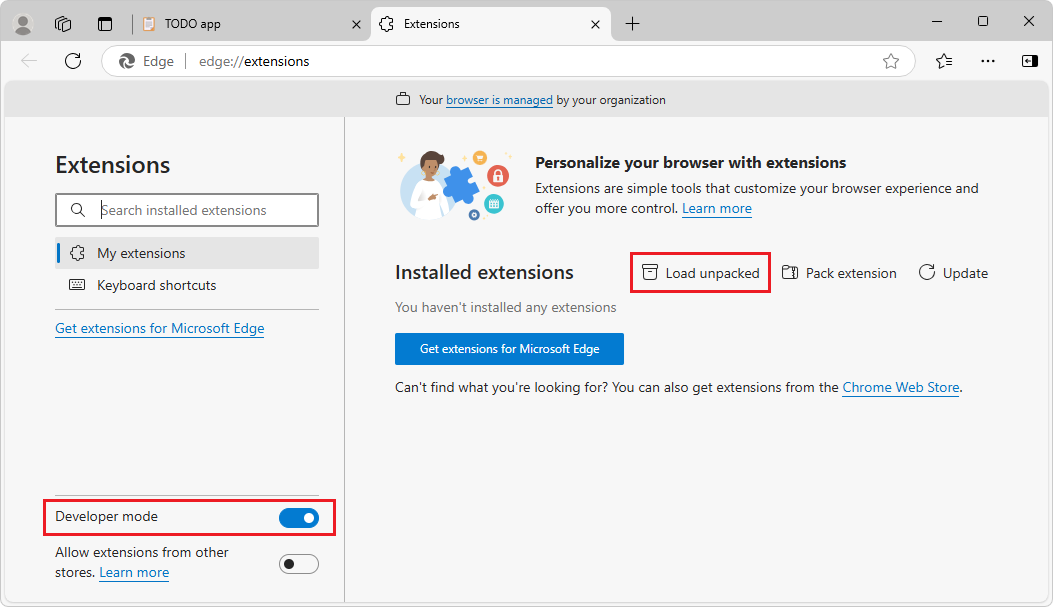
Turn on the Developer mode toggle.
When installing the sample extension for the first time, click the Load unpacked (
 ) button. The Select the extension directory dialog opens.
) button. The Select the extension directory dialog opens.Select the directory that contains the extension's source files, such as
manifest.json.Example path:
C:\Users\localAccount\GitHub\MicrosoftEdge-Extensions\Extension samples\extension-getting-started-part2\extension-getting-started-part2Click the Select Folder button.
The Select the extension directory dialog closes.
The extension is installed in the browser, similar to an extension that's installed from the store:
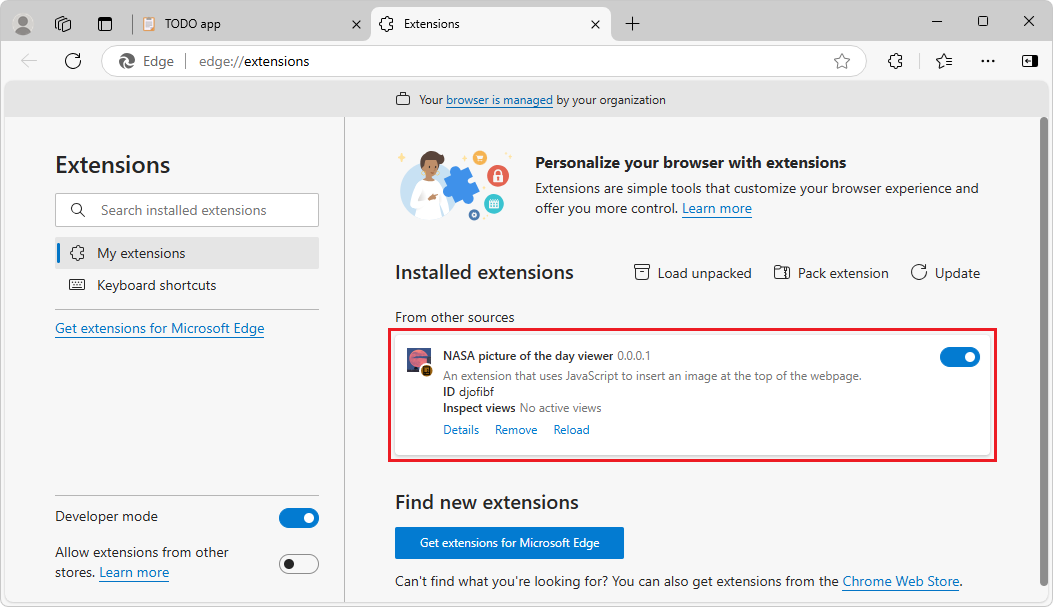
Run the sample
Go to a webpage, such as TODO app, in a new window or tab. The tab must not be empty, and must not be the Manage Extensions page, because this sample inserts content into the current webpage.
In Microsoft Edge to the right of the Address bar, if this icon is displayed, click the Extensions (
 ) button. Or, select Settings and more (...) > Extensions.
) button. Or, select Settings and more (...) > Extensions.The Extensions pop-up opens:

Click the extension's icon or name (NASA picture of the day viewer).
The extension opens, and the extension's icon is added next to the Address bar and Extensions (
 ) icon.
) icon.A pop-up opens, containing a small HTML page with a title, instructions, and a Display button:

Click the Display button.
stars.jpegis inserted into the top of the current webpage in the current tab, pushing the webpage's content down below the image:
Click the
stars.jpegimage that's filling the top of the webpage. That image element is removed from the DOM tree and webpage, and the current webpage is restored, shifting its content back up to the top of the tab.
The extension sends a message from the extension icon's pop-up, and dynamically inserts JavaScript running as content in the browser tab. The injected content sets the image element to display stars.jpeg in the top of the current webpage, and then removes the image when you click the image.
See also:
Study the sample
In the following sections, you study the sample. After that, to develop your own Microsoft Edge extension, you can copy and modify the sample's directory, and install and test the resulting extension.
Files and directories
The sample has the following directory structure and files.
Example path for the sample:
C:\Users\localAccount\GitHub\MicrosoftEdge-Extensions\Extension samples\extension-getting-started-part2\extension-getting-started-part2
Directories and files in the \extension-getting-started-part2\ directory:
/content-scripts/
content.js
/icons/
nasapod16x16.png
nasapod32x32.png
nasapod48x48.png
nasapod128x128.png
/images/
stars.jpeg
/lib/
jquery.min.js
/popup/
popup.html
popup.js
manifest.json
- The
/content-scripts/directory containscontent.js, which is the injected script that's injected into the current webpage. - The
/icons/directory contains versions of a.pngfile that's used to represent the extension near the browser's Address bar. - The
/images/directory containsstars.jpeg, which is displayed in the extension's pop-up. - The
/lib/directory containsjquery.min.js, which is a predefined, minified file, a minified version of jQuery, used in content scripts that you're injecting. - The
/popup/directory containspopup.html, which defines the webpage content that's displayed in the extension's pop-up. manifest.jsoncontains basic information about the extension.
Strategy to update the webpage to insert the image at the top (stars.jpeg)
This sample includes a content script that's injected into the webpage that's loaded in the current browser tab.
When you run the extension sample, the initial popup HTML page is displayed (
popup.html), showing a title, instructions, and the Display button.When you click the Display button, the JavaScript (
popup.js) for the initial popup page sends a message to the content script (content.js) that's running on the tab page. The message specifies which image file should be displayed.The content script (
content.js) running on the tab page receives the message, and displays the specified image file (stars.jpeg).
The initial popup webpage (popup.html)
popup.html is specified in the manifest file as the webpage to display in the extension's initial popup. The manifest file contains the key field "default_popup": "popup/popup.html". This sample's popup.html file is a small webpage that contains a title, instructions, and a Display button.
/popup/popup.html:
<!DOCTYPE html>
<html>
<head>
<meta charset="utf-8" />
<style>
body {
width: 500px;
}
button {
background-color: #336dab;
border: none;
color: white;
padding: 15px 32px;
text-align: center;
font-size: 16px;
}
</style>
</head>
<body>
<h1>Display the NASA picture of the day</h1>
<h2>(click the image to remove it from the webpage)</h2>
<button id="sendmessageid">Display</button>
<script src="popup.js"></script>
</body>
</html>
The Display button is added by the above code.
JavaScript (popup.js) for the initial pop-up page, to send a message to the injected JavaScript
popup.js sends a message to the content script (content.js) that's temporarily injected into the browser tab. To do that, popup.js adds an onclick event to the pop-up webpage's Display button, which has the ID sendmessageid:
/popup/popup.js (portion):
const sendMessageId = document.getElementById("sendmessageid");
if (sendMessageId) {
sendMessageId.onclick = function() {
// do something
};
}
In the following popup.js code, the sample uses chrome.tabs.query to find the current browser tab, and then uses chrome.tabs.sendMessage to send a message to that tab.
In that message, you must include the URL to the image you want to display. Make sure that you send a unique ID to assign to the inserted image.
To send a unique ID to assign to the inserted image, a couple different approaches are possible:
- Approach 1: Let the content insertion JavaScript generate that image ID. We won't use that approach here, for reasons explained below.
- Approach 2: Generate that unique ID here in
popup.js, and then pass that ID to the not-yet-created content script. We'll use this approach.
The sample also passes in the current tab ID, which is described later in this article:
/popup/popup.js (complete):
const sendMessageId = document.getElementById("sendmessageid");
if (sendMessageId) {
sendMessageId.onclick = function() {
chrome.tabs.query({ active: true, currentWindow: true }, function(tabs) {
chrome.tabs.sendMessage(
tabs[0].id,
{
url: chrome.runtime.getURL("images/stars.jpeg"),
imageDivId: `${guidGenerator()}`,
tabId: tabs[0].id
},
function(response) {
window.close();
}
);
function guidGenerator() {
const S4 = function () {
return (((1 + Math.random()) * 0x10000) | 0).toString(16).substring(1);
};
return (S4() + S4() + "-" + S4() + "-" + S4() + "-" + S4() + "-" + S4() + S4() + S4());
}
});
};
}
The content script message listener (content.js)
Here's the content-scripts\content.js file that gets injected into every browser tab page based on the content-scripts section in manifest.json:
chrome.runtime.onMessage.addListener(function(request, sender, sendResponse) {
$("body").prepend(
`<img src="${request.url}" id="${request.imageDivId}"
class="slide-image" /> `
);
$("head").prepend(
`<style>
.slide-image {
height: auto;
width: 100vw;
}
</style>`
);
$(`#${request.imageDivId}`).click(function() {
$(`#${request.imageDivId}`).remove(`#${request.imageDivId}`);
});
sendResponse({ fromcontent: "This message is from content.js" });
});
This code registers a listener by using the chrome.runtime.onMessage.addListener Extension API method. This listener waits for messages like the one you sent from the popup.js described earlier with the chrome.tabs.sendMessage Extension API method.
The first parameter of the addListener method is a function whose first parameter, request, is the details of the message being passed in. Remember, from popup.js, when you used the sendMessage method, those attributes of the first parameter are url and imageDivId.
When an event is processed by the listener, the function that is the first parameter is run. The first parameter of that function is an object that has attributes as assigned by sendMessage. That function simply processes the three jQuery script lines.
The first script line appends an
imgelement right below thebodyof the browser tab that has theslide-imageclass assigned as well as theimageDivIdas the ID of that image element.The second script line dynamically inserts into the DOM header a <style> section that's assigned as a
slide-imageclass to theimgelement.The third script line adds a
clickevent that covers the entire image allowing the user to select anywhere on the image and that image is removed from the page (along with it is event listener).
How stars.jpeg is made available from any browser tab
To make images/stars.jpeg available from any browser tab:
popup.js(above) uses thechrome.runtime.getURLAPI.- The manifest (below) specifies that
web_accessible_resourcesof type.jpegmatch all URLs.
The sample injects the image by using the src attribute of the img element into the content page. The content page is running on a unique thread that isn't the same as the thread running the extension. The static image file must be exposed as a web asset, for it to work correctly.
Another entry is added in the manifest.json file to declare that the image is available to all browser tabs:
/manifest.json (portion):
"web_accessible_resources": [
{
"resources": ["images/*.jpeg"],
"matches": ["<all_urls>"]
}
]
The code in the popup.js file sends a message to the content page that's embedded in the current active tab page.
How resources are listed in the manifest (manifest.json)
The sample creates and inject the content page that's embedded on the current active tab page. manifest.json includes the content-scripts and web_accessible_resources, as follows:
/manifest.json (complete):
{
"name": "NASA picture of the day viewer",
"version": "0.0.0.1",
"manifest_version": 3,
"description": "An extension that uses JavaScript to insert an image at the top of the webpage.",
"icons": {
"16": "icons/nasapod16x16.png",
"32": "icons/nasapod32x32.png",
"48": "icons/nasapod48x48.png",
"128": "icons/nasapod128x128.png"
},
"action": {
"default_popup": "popup/popup.html"
},
"content_scripts": [
{
"matches": [
"<all_urls>"
],
"js": ["lib/jquery.min.js","content-scripts/content.js"]
}
],
"web_accessible_resources": [
{
"resources": ["images/*.jpeg"],
"matches": ["<all_urls>"]
}
]
}
The manifest's content_scripts section injects JavaScript into all browser tabs
In the content_scripts key section of the manifest file, the matches attribute is set to <all_urls>, which means that .js (or .css) files that are specified in the content_scripts key section are injected into all browser tab pages when each tab is loaded. The allowed files types that can be injected are JavaScript (.js) and CSS (.css).
In this sample, the following files are specified:
content-scripts/content.jslib/jquery.min.js
How jQuery support is added (jquery.min.js)
jquery.min.js is a predefined, minified file to support jQuery expressions starting with $ in content.js.
In injected content scripts, it's common to use jQuery ($). This sample includes a minified version of jQuery, residing in the extension package as lib\jquery.min.js.
The content script (content.js) runs in its own sandbox, which means that the jQuery that's injected into content.js isn't shared with the current webpage.
Understanding the thread
Each tab page (and extension) runs in its own thread.
Even if the browser tab contains a webpage that runs JavaScript code, the content.js script that's injected in that browser tab by the extension doesn't have access to that JavaScript code. The injected content script only has access to the DOM of the webpage.
Next steps
To develop your own Microsoft Edge extension, you can copy and modify the sample's directory, and install and test the resulting extension.
See also
GitHub:
- MicrosoftEdge-Extensions repo.
- /extension-getting-started-part2/ - source code of the Part 2 sample.